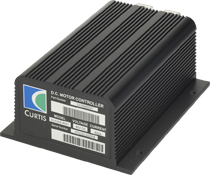
Home / Curtis


Series Motor Controller
1253
Model 1253 is a high-power hydraulic pump controller which provides both digital input and analog throttle based control of DC series wound motors. It features microprocessor based logic with programmable parameters and offers maximum flexibility for minimum cost.
We are the leading supplier of Curtis DC Motor Controller in chennai, made from high quality material at competitive prices.
Features
CANbus
A controller-area network (CAN or CAN-bus) is a serial communications bus standard, allowing electronic control modules to communicate with each other within a vehicle. It was originally designed by Bosch specifically for automotive applications. CANopen is an international standard, and is a higher-layer CAN protocol for embedded control systems. CANopen has become the standard communication bus for most electric vehicle applications including forklift trucks and other materials handling vehicles. SAE J1939 is an alternate higher-level protocol that is commonly used for IC engine-powered vehicle applications, such as agricultural vehicles, construction vehicles, and automobiles. Most recent Curtis controllers adhere to the CANopen protocol and support the DS401 IO-device profile standard. Earlier Curtis CAN controllers adhere to the CAN2.0B standard, but run proprietary higher-level protocols called Curtis Nodes 1.0 and Curtis Nodes 2.0. Please note that SAE J1939-compliant variants of certain Curtis products are possible -please contact us for more information.
Plug Braking
Plug braking allows a vehicle to be braked electrically by selecting the opposite direction with the forward/reverse switch without releasing the throttle. When the motor is reversed, the armature acts as a generator and the controller regulates the current in the motor field winding to give an appropriate level of plug braking torque. The vehicle brakes smoothly to a stop, then accelerates in the other direction. Plug braking is supported on most Curtis Series controllers intended for traction control applications.
Application
| Application | Pump |
| Vehicle Type | Material Handling |
| Max Voltage [VDC] | 80 |
| Armature Current (2 min) [A] | 600 |
| Plug Braking | No |
| Programmable Parameters | Yes |
| Line Contactor Driver | Yes |
| CANbus | No |
| IP Rating | IP 54 |
Do you have any query? Call +(91)-9822775764. Or Request a Quote
Designed & developed by Satkar Infotech
Terms & Conditions |
Privacy Policy |
Dispute Policy
Copyright © 2017 by MEL Services.








